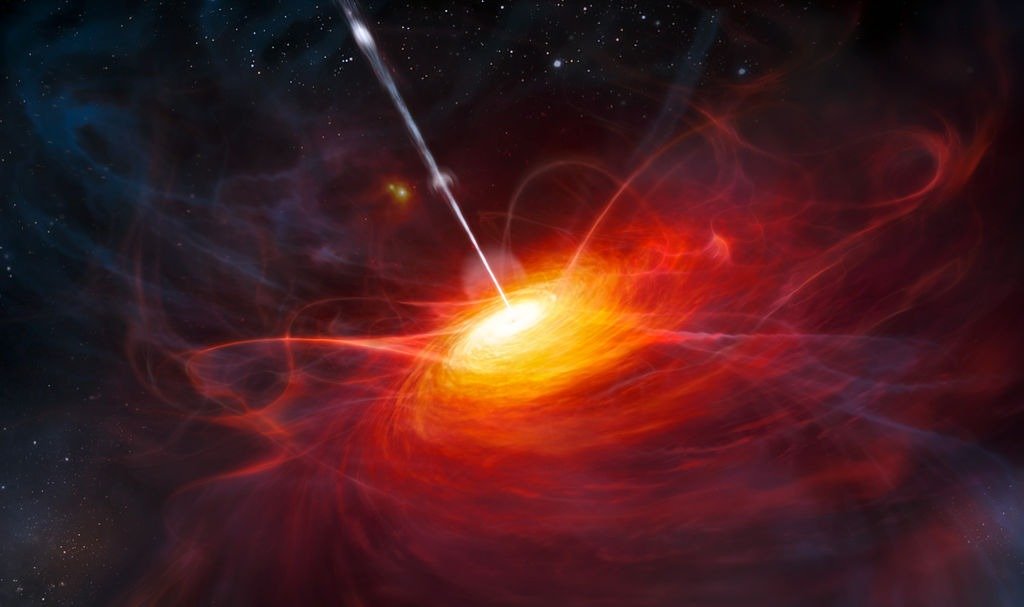Image: An artist’s impression of the distant quasar ULAS J1120+0641
Credit: ESO/M. Kornmesser CC BY 4.0 via Wikimedia Commons
Source: https://www.eso.org/public/images/eso1122a/
Supermassive Black Holes (SMBHs) are some of the biggest – literally – mysteries in the Universe. They can grow in size up to billions of solar masses and astronomers think that every galaxy has one of these monstrosities in its centre. Our own Galaxy’s SMBH, called Sagittarius A*, is about 4 million times as massive as the Sun.
We don’t yet understand how these monstrosities form, but one of the theories suggests that SMBHs start as smaller, ‘seed’ black holes that grow bigger by devouring the gas from the surrounding regions. We observe this ‘feeding’ process as Active Galactic Nuclei (AGN), such as quasars, blazars and Seyfert galaxies.
ACTIVE GALACTIC NUCLEI
Many galaxies have extremely bright central regions, or nuclei, that sometimes outshine the rest of the galaxy. Astronomers call such nuclei Active Galactic Nuclei (AGN) and think that they are powered by a SMBH in their centres. What makes these objects so luminous? It is the gas in the accretion disk [around a SMBH] that gets frictionally heated as it spirals into a black hole.
Sometimes the in-falling matter is accelerated so much that some of it ends up being ejected! In that case we observe powerful beams of particles that dash out along the SMBH’s axis of rotation at relativistic speeds.
QUASARS
The most luminous of all the AGN are Quasars. The word Quasar is short for quasi-stellar-radio-source, although, as we later found out, only about 10% of the quasars are radio loud. These objects are bright in infrared, X-ray and soft gamma-ray bands. In the visible light they look like bright stars surrounded by fuzzy halos.
Quasars are some of the most distant and therefore early objects. Most of them – and we detected hundreds of thousands of quasars – are billions of light years away from us. Quasars used to be common in the early Universe. This is not surprising given that in the past there was more free gas for their black hole engines to feed on. As the time passed and more gas converted into stars, less gas became available for the quasars’ SMBHs to consume. Most nearby galaxies we see today probably had a central quasar in the past that has since gone quiet.
But how far back in time can we find quasars? That is, if the Universe started with matter ➡️ that clumped into first stars ➡️ that collapsed into first black holes ➡️ that accreted enough material to become supermassive black holes ➡️ that began to ‘feed’ and became visible as quasars, then there should have been a particular moment when the first quasars have emerged, right?
THE SEARCH FOR THE MOST DISTANT QUASARS
Since 2017, the title of the most distant quasar with a measured redshift* of z=7.54, belonged to ULAS J1342+0928. The light that we see from this quasar was emitted ‘only’ 690 million years after the Big Bang. Its central SMBH was estimated to be 0.8 billion solar masses.
* A note on redshift…
The light from the quasars is extremely redshifted, i.e. stretched to longer wavelengths. This is cosmological redshift, it results from the expansion of space the light travels through. When talking about quasars and other extremely far-away objects, astronomers usually refer to their redshift (z), rather than distance. It is helpful to remember that the farther the object, the higher the cosmological redshift z. For example, present time corresponds to z=0, the farthest galaxy (NG-z11) is at z=10.957. Quasars have redshifts between z=0.05 and z=7 (only several were found at redshifts higher than 7), with a peak at z=2.
❓ Can you guess what radiation has the highest redshift observed?
THE 2021 DISCOVERY
Last week, on January 12th 2021, the team led by Feige Wang (University of Arizona) announced the discovery of an even earlier quasar. This quasar, J0313-1806, dates back to 670 million years after the Big Bang. It is twice as massive as the one found in 2017 and is 1000 times brighter than the Milky Way!
J0313-1806 is thought to sit inside a galaxy with a very active ‘ongoing’ star formation. The host galaxy produces 200 Solar Masses worth of stars per year (to compare, the Milky Way’s current star formation rate is about 1 solar mass a year). Another interesting feature of J0313-1806 is the extremely high velocity outflow – up to 20% of the speed of light.
While not the biggest quasar we know of, J0313-1806 definitely made astronomers scratch their heads. The Problem? The ginormous black hole that powers this quasar formed just 670 million years after the Big Bang, which leaves very little time for the ‘seed’ it grew from to form. Dr Wang and his team estimate that even if the ‘seed’ accumulated material at the top speed, the initial mass of the seed black hole should have been 10 000- 100 000 solar masses. That is too heavy to be a stellar black hole! So how did the J0313-1806 form? The researchers propose that an alternative mechanism, called direct collapse (when a big enough cloud of gas collapses straight into a black hole without forming a star first), was at play here. But, truth to be told, nobody knows for sure!
The search for the earliest Supermassive Black Holes and the quest to explain their cosmic origin goes on!
Still curious about quasars?
Visit our Portable Planetarium to learn more about quasars, black holes and other cosmic wonders!
Any questions?
Let our Star Dome team know in the comments below! We would love to hear from you!

